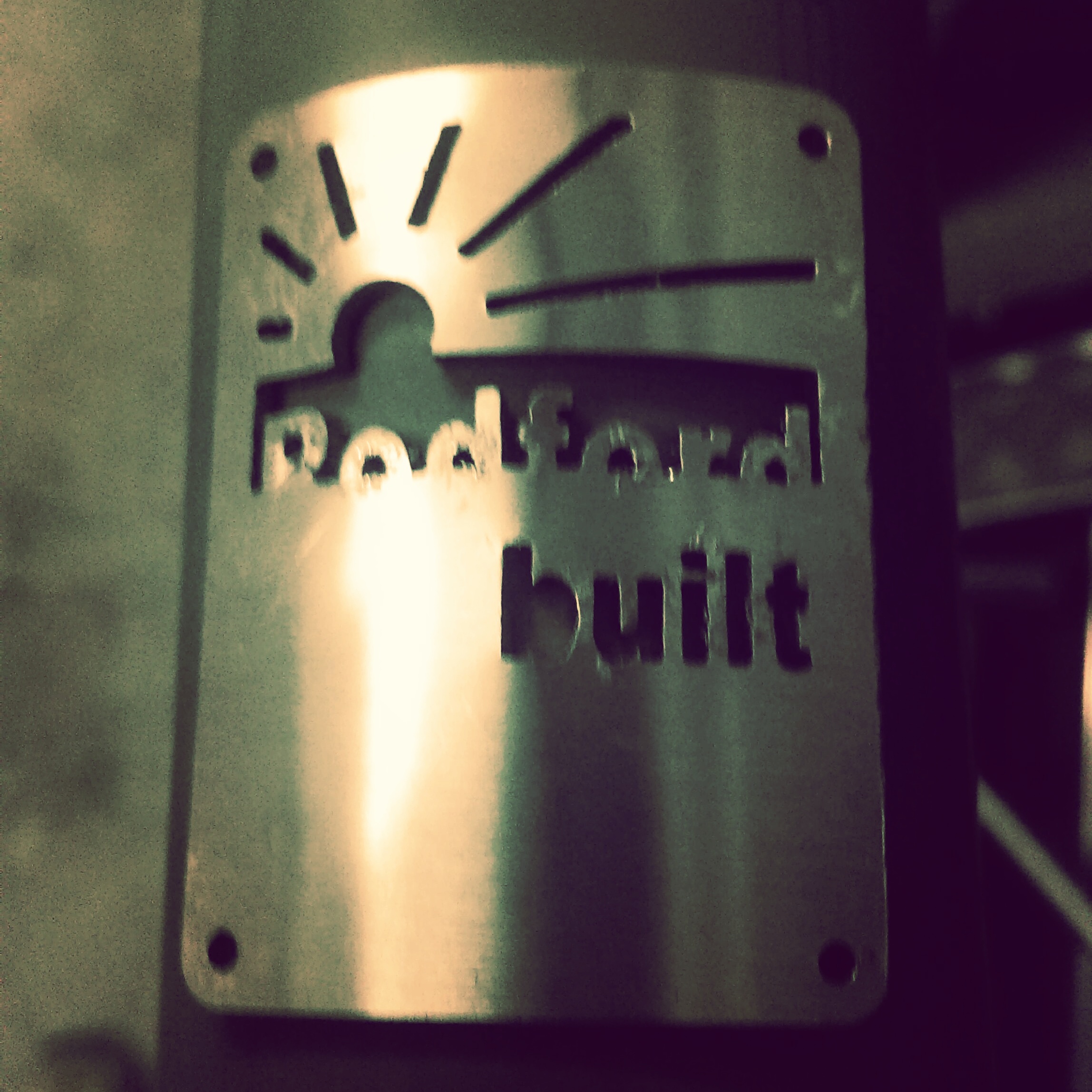Recently there has been talk of adding an anti-lock brake system (ABS) to bicycles. This is an exciting development and so we thought it relevant to look at how these systems work and what benefits they may have for the rider.History.There has been interest in reducing wheel slip from the earliest days of vehicles. The first successful application was in 1920 aboard early aeroplanes. This was a mechanical system employing a flywheel next to the landing wheel. Under braking if the wheel slipped the flywheel would continue to rotate and this speed difference would activate a hydraulic release valve to reduce brake system pressure - ingenious. The result was a massive 30% improvement is stopping distances because pilots could use full braking under all conditions.Much later in the 1960's is was again the aircraft industry that lead the way when they developed the first successful electronic system, which was fitted to the supersonic passenger jet Concorde.In the early 1970's car manufacturers started to experiment with electronic systems and the first successful integration was a offered as an option on the 1978 Mercedes Benz W116 S-class. This was a four channel system using Bosch electrics and became the basis of the modern ABS system used today.Today, ABS is a requirement of all modern cars and is instrumental in helping drivers avoid accidents and achieved greater braking efficiency in an emergency. Unlike Seat belts and Air bags which are great life savers, the ABS system is designed to avoid an accident in the first place, so it is known as an active, rather than passive, safety system.WorkingsAn electronic ABS system is relatively simple and requires a wheel speed monitoring system, and a hydraulic actuator to control brake pressure. Under braking a computer monitors each wheel speed, however this number alone does not suffice. For example once a car is stopped then seeing a zero wheel speed is not indicative of a skid, it is just the car is stopped and in this situation the ABS system should not be active. Much better is to look at the wheel speed and calculate the deceleration profile. Normally this would show a gradual decrease in speed, but if the wheel should "lock up" the deceleration becomes infinite as shown in the chart below.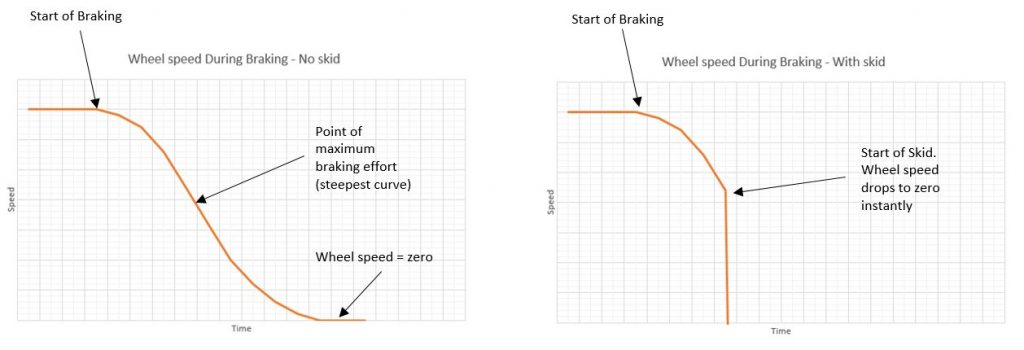 When a locked wheel is detected, the hydraulic brake pressured being requested by the driver is maintained, but it is pulsed with an actuator so that the wheel is braked and released 160 times a second. Under hard braking typical hydraulic pressure might be 1200psi; the actuators have to be strong enough to push back against this force and it is not uncommon for car headlights to dim when ABS is activated, such is the energy needed to drive the actuators.EffectivenessThe effectiveness of an ABS system is a hotly debated subject and it is worth understanding how to achieve maximum braking effort before considering the value of ABS.Interestingly, most people often consider a skidding wheel to have less braking effort than a rolling one. This is correct in general because static friction of an object is higher than dynamic friction. You experience this when you try and push a heavy box across the floor; it is noticeably harder to get the box started, than to keep it moving. From this we can deduce that a rolling wheel has more grip than a sliding one. However there is a subtle caveat here. Although this might be true for a box on the floor, a tyre is pliable, and in the world of adhesion and contact mechanics, the maximum braking effort is actually achieved with a small amount of wheel slip. Without getting into the science behind this phenomena, the graph below shows the expected output from empirical testing and highlights that the greatest braking effort is attained with around 20% tyre slip.
When a locked wheel is detected, the hydraulic brake pressured being requested by the driver is maintained, but it is pulsed with an actuator so that the wheel is braked and released 160 times a second. Under hard braking typical hydraulic pressure might be 1200psi; the actuators have to be strong enough to push back against this force and it is not uncommon for car headlights to dim when ABS is activated, such is the energy needed to drive the actuators.EffectivenessThe effectiveness of an ABS system is a hotly debated subject and it is worth understanding how to achieve maximum braking effort before considering the value of ABS.Interestingly, most people often consider a skidding wheel to have less braking effort than a rolling one. This is correct in general because static friction of an object is higher than dynamic friction. You experience this when you try and push a heavy box across the floor; it is noticeably harder to get the box started, than to keep it moving. From this we can deduce that a rolling wheel has more grip than a sliding one. However there is a subtle caveat here. Although this might be true for a box on the floor, a tyre is pliable, and in the world of adhesion and contact mechanics, the maximum braking effort is actually achieved with a small amount of wheel slip. Without getting into the science behind this phenomena, the graph below shows the expected output from empirical testing and highlights that the greatest braking effort is attained with around 20% tyre slip.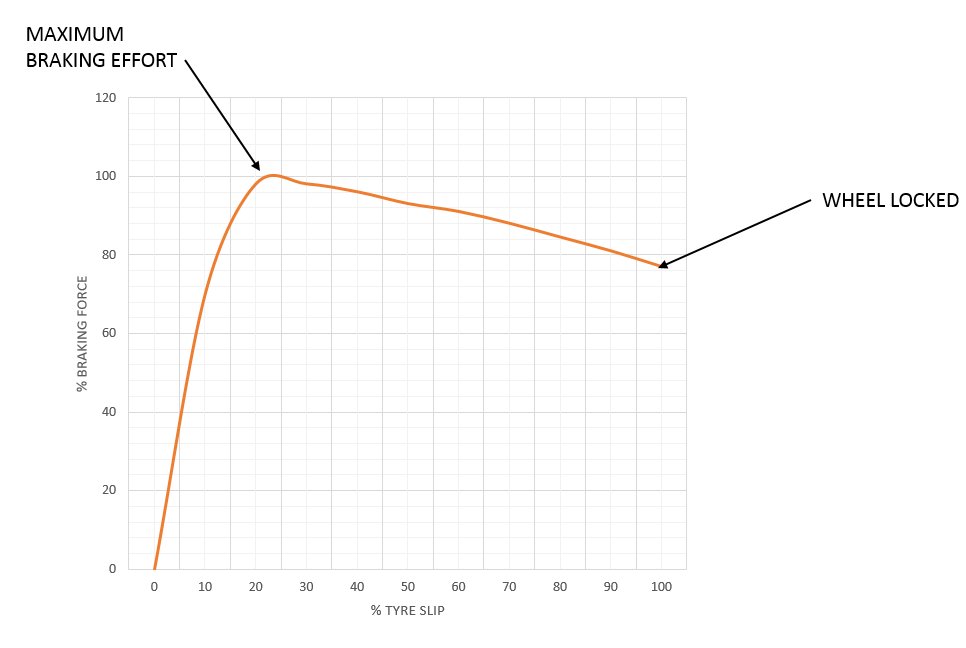 A racing driver in a well balanced car will always try to brake at this braking limit which is known as threshold braking. This is the quickest way to stop a vehicle. The same is true of cornering where a small amount of tyre slip will allow a faster cornering speed than no slip at all. This goes to explain why racing cars get through so many tyres in a single event.The graph also shows that once a wheel is 100% slipping (or locked in a skid), the braking effort is reduced to around 80%.Note that this graph assumes a dry asphalt road. If the car were on a wet road or even ice, then the braking force for the skidding wheel would be massively reduced. This is where skilful driving and more careful braking is needed.Getting back to ABS.There are two benefits to ABS. One is the braking effort that we have just been looking at. For many situations (not all) an active ABS system will give the shortest stopping distance, maximising braking effort by holding the wheel slip close 18% whatever the tyre/road condition.A second benefit is that because the wheel is allowed to rotate during braking, then directional control is maintained and the driver has the ability to steer and brake.A locked wheel has no directional control and this is a common cause for people sliding off the road. With locked wheels it doesn't matter which way they are pointing they are effectively skiing on the surface and the car's momentum will carry it in a single direction. However if you allow the wheels to momentarily rotate then it becomes possible to brake and steer, maybe avoiding an obstacle in the process.Bicycles.On single track vehicles, ABS has even more potential because you can virtually eliminate the risk of the bike sliding out. I've only fallen off a bike a few times and every time it was on ice and it was the loss of grip on the front wheel under braking that was the cause.Being able to brake and turn would also be significantly reassuring. When cornering, some of the tyre's grip is needed to corner. This means the grip available for braking is reduced and it is easier for the wheels to skid. A clever ABS system would allow a rider to always stop in the shortest distance whilst remaining in control and staying upright in the process.Intelligent electronic ABS is now a possibility on an E-bicycle thanks to the substantial batteries they carry which have the capacity to drive the strong actuators needed. This, combined with a hydraulic brake system that can be modulated, means that ABS is a possibility for the future of modern e-bikes.Not got an E-bike?Well in the past there have been pure mechanical systems such as this design from Brovedani which might be of interest. The system has standard cantilever brakes, but with a roller in front of the brake pad. As it contacts the rim the roller drives a cam which pulses the brake pad in and out slightly during braking. Of course this would happen during normal braking not just during a skid but it is a interesting innovation nonetheless.
A racing driver in a well balanced car will always try to brake at this braking limit which is known as threshold braking. This is the quickest way to stop a vehicle. The same is true of cornering where a small amount of tyre slip will allow a faster cornering speed than no slip at all. This goes to explain why racing cars get through so many tyres in a single event.The graph also shows that once a wheel is 100% slipping (or locked in a skid), the braking effort is reduced to around 80%.Note that this graph assumes a dry asphalt road. If the car were on a wet road or even ice, then the braking force for the skidding wheel would be massively reduced. This is where skilful driving and more careful braking is needed.Getting back to ABS.There are two benefits to ABS. One is the braking effort that we have just been looking at. For many situations (not all) an active ABS system will give the shortest stopping distance, maximising braking effort by holding the wheel slip close 18% whatever the tyre/road condition.A second benefit is that because the wheel is allowed to rotate during braking, then directional control is maintained and the driver has the ability to steer and brake.A locked wheel has no directional control and this is a common cause for people sliding off the road. With locked wheels it doesn't matter which way they are pointing they are effectively skiing on the surface and the car's momentum will carry it in a single direction. However if you allow the wheels to momentarily rotate then it becomes possible to brake and steer, maybe avoiding an obstacle in the process.Bicycles.On single track vehicles, ABS has even more potential because you can virtually eliminate the risk of the bike sliding out. I've only fallen off a bike a few times and every time it was on ice and it was the loss of grip on the front wheel under braking that was the cause.Being able to brake and turn would also be significantly reassuring. When cornering, some of the tyre's grip is needed to corner. This means the grip available for braking is reduced and it is easier for the wheels to skid. A clever ABS system would allow a rider to always stop in the shortest distance whilst remaining in control and staying upright in the process.Intelligent electronic ABS is now a possibility on an E-bicycle thanks to the substantial batteries they carry which have the capacity to drive the strong actuators needed. This, combined with a hydraulic brake system that can be modulated, means that ABS is a possibility for the future of modern e-bikes.Not got an E-bike?Well in the past there have been pure mechanical systems such as this design from Brovedani which might be of interest. The system has standard cantilever brakes, but with a roller in front of the brake pad. As it contacts the rim the roller drives a cam which pulses the brake pad in and out slightly during braking. Of course this would happen during normal braking not just during a skid but it is a interesting innovation nonetheless.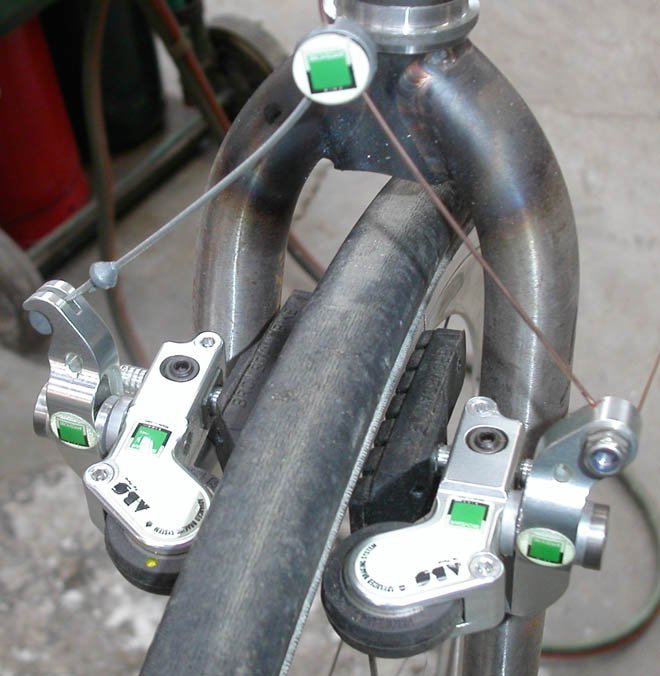 Another related system could be described as Torque Arm Braking. This system was first trialled by Franklin James Calderazzo. He produced a working prototype system where the rider applied just the rear brake of the bike. The torque reaction of the rear brake was then used to apply the front brake thereby ensuring that the front wheel would only received as much braking effort as the back wheel. In any road going vehicle the back wheel will usually skid first under braking, because of the weight transfer to the front so this would, in theory, prevent the front wheel locking which would help a rider remain in control. Clever stuff.
Another related system could be described as Torque Arm Braking. This system was first trialled by Franklin James Calderazzo. He produced a working prototype system where the rider applied just the rear brake of the bike. The torque reaction of the rear brake was then used to apply the front brake thereby ensuring that the front wheel would only received as much braking effort as the back wheel. In any road going vehicle the back wheel will usually skid first under braking, because of the weight transfer to the front so this would, in theory, prevent the front wheel locking which would help a rider remain in control. Clever stuff.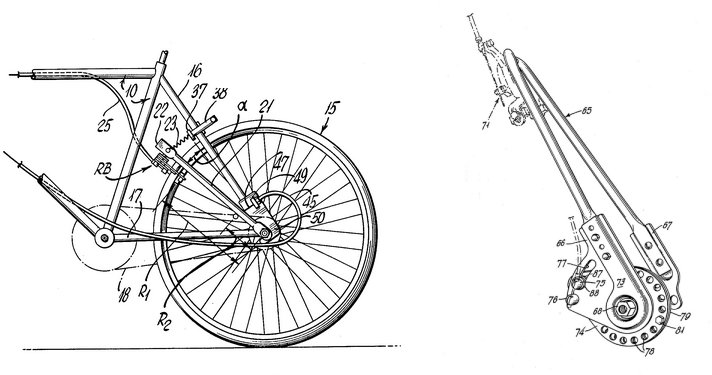 Of course this would not necessarily give you the best braking for all conditions as braking effort of the front wheel would be limited to whatever the back wheel could provide or at least regulated at some point below its optimum; but I still wish I'd thought of it.At Rodford we like to stay up with the latest technology and so we'll be watching ABS development with interest, but rest assured we value reliability and practicality above everything else so we'll only adopt technologies that are useful to/wanted by our customers.
Of course this would not necessarily give you the best braking for all conditions as braking effort of the front wheel would be limited to whatever the back wheel could provide or at least regulated at some point below its optimum; but I still wish I'd thought of it.At Rodford we like to stay up with the latest technology and so we'll be watching ABS development with interest, but rest assured we value reliability and practicality above everything else so we'll only adopt technologies that are useful to/wanted by our customers.
We design and build bicycles in the South West of England, just outside Bristol.
Every bike is individual, each steel frame fashioned by hand, each weld unique and good function guaranteed
we are challenging the established notions of what’s possible by bike.
Nice people building good bikes.
